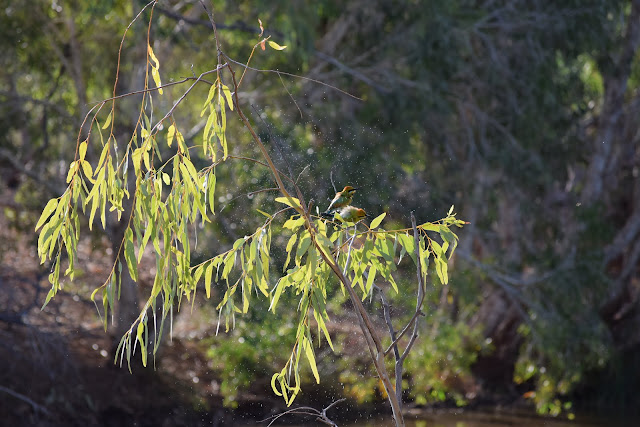The road less (rarely?) traveled
It feels hard for anything to top the excitement of
yesterday. I don’t know how many chances I’ll get to be within inches of
crocodiles longer than my car.
Luckily, fieldwork is a constant adventure. There’s been
plenty of exhausting nights with swarms of bugs in my eyes (why do they love
flying into your eyeball?!?, never-ending
sweat, and clouds of mozzies.
But there is yet to be a night where I haven’t
found some awesome animals.
I couldn’t help myself, before the sun went down I had to check on my original field site
at the dam.
As you, no doubt, suspected…
 |
| Yep, still on fire |
Getting to the new site is, ummm, interesting at times (is 'gnarly' still a thing? I think that's probably the best description). I wouldn’t
call the road out there ‘well worn’ by any measure. I’m just glad I don’t have
to take my old 88’ Honda CRX out for this (RIP white lightin’), I probably
wouldn’t make it past the first cow paddie.
Part I
Part II
 |
| White-bellied sea eagle (Haliaeetus leucogaster) |
I didn’t see this bad boy at my field site, but I was glad
to finally see one. I’ve had my eye out since we heard about aboriginal
folklore in Canberra (Say it with me now, like a true Ozzie, Can-Brr-ah). The
original natives around the field station called themselves the Mak Mak, which
is also what they called these birds. The group and the birds depend on healthy
water systems for fishing so they’d follow the eagles to find good habitat.
 |
| Forest kingfisher (Todiramphus macleayii) |
These birds can be pretty rugged. I didn’t get a chance to
get a good photo of one in the act, but when they catch bugs they bash them
against tree branches to kill them before eating.
 |
| Common tree snake (Dendrelaphis punctulatus) |
I’ve had my eye out for one of these since I got here.
Unfortunately I didn’t read up on them much and when I grabbed it, I quickly experienced
one of their main defensive maneuvers, probably the worst musk smells ever.
There are a few snakes I won’t pick up anymore. Not necessarily because they’re
dangerous and/or bitey, but because of their terrible smell. Garter snakes,
water snakes, and I can now officially add common tree snakes to the list.
They’re pretty to look at, but I don’t think I’ll be grabbing any more while in
Australia. Pee yew!
 |
| Saint Andrews cross (Argiope sp.) |
They’re not listed as ‘dangerous’, but this is yet another
example of a terrifying spider that love to weave webs at face height. Luckily
there aren’t too many real hazardous spiders around here. I’ll be the first to
admit that I give a pretty good squeal every time I walk through a web and
think about one of these on my neck. Ick.
 |
| Bynoe’s gecko (Heteronotia binoei) |
Not only do they blend in remarkably well, but in certain parts of Australia these geckos reproduce by parthenogenesis,
meaning embryos grow and develop into young without any fertilization by males.
No boys allowed.
 |
| Green tree ant (Oecophylla smaragdina) |
These ants build balloon shaped nests in the trees out of
leaves. Their larvae secrete a silk that workers use to weave their nest (hence
their other common name: weaver ant). I haven’t experienced it personally, but
I hear if you piss them off they’ll bite you and then squirt a burning fluid
onto the cut.
As much as I love driving the roads at night looking for
snakes, there is no radio stations out here and the 2 albums I have downloaded
on my phone are getting a little old. Another perk to my new field site is that
once you get here it’s mostly old fashion hoofin’ it to find the snakes I’m
after.
Walking along through the grass, bushes, and leaves is more
productive than you might think. This place is really rich with diversity, even
during the winter dry months while I’m here (I still get confused and have to
remember I’m in the southern hemisphere).
 |
| Children’s python (Antaresia childreni) |
All told I managed to wrangle up 12 snakes last night! Eight
water pythons and four children’s. Not bad new field site, not bad at all.
 |
A pretty good haul |










































